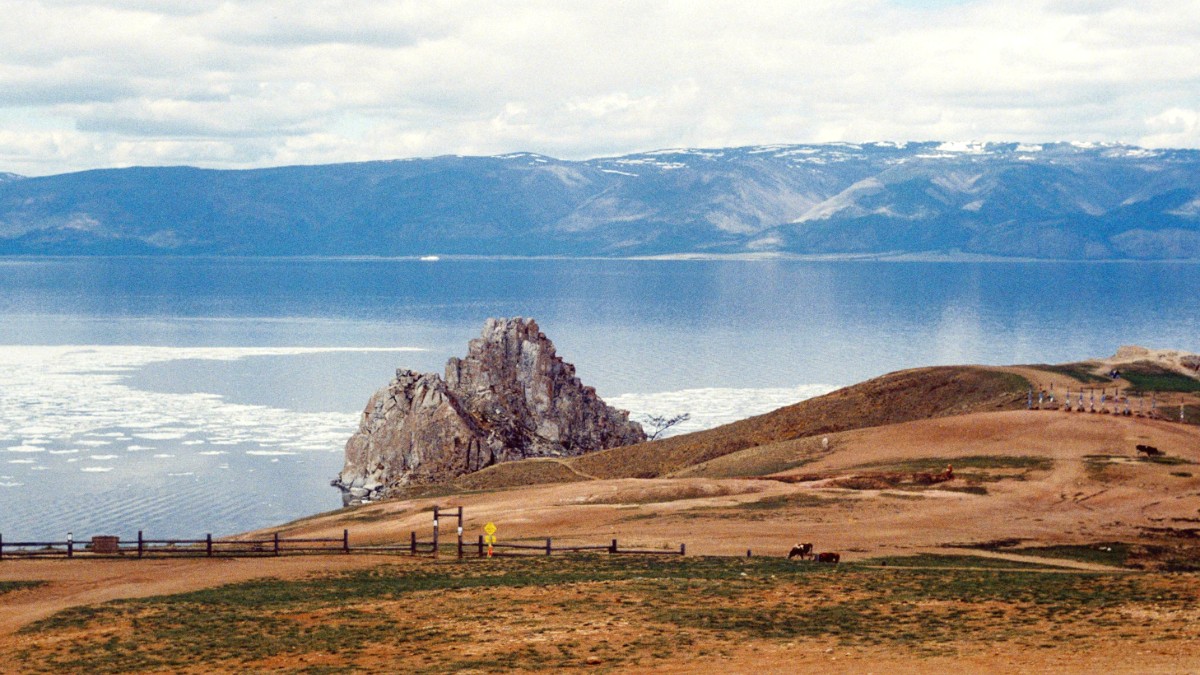
Russia
Mountains and hills surround the lake, contributing to its dramatic scenery. On the western side, the Baikal Range rises sharply from the shore, while the Barguzin Range dominates the eastern side. These ranges channel numerous rivers and streams into the lake – over 336 rivers feed Baikal, though only one, the Angara River, flows out. This single outflow marks a remarkable feature, as the Angara eventually joins the Yenisei River, flowing north to the Arctic Ocean. The lake's depth marks its most striking geographical feature. The maximum depth of 1,642 meters (5,387 feet) places it as the deepest lake globally. Olkhon Island, the largest island within Lake Baikal, is a significant geographical landmark.
The deep, cold waters stay remarkably pure due to the activity of microscopic organisms and unique water circulation patterns that act as a natural filtration system. Olkhon Island lies on the western side of the lake, stretching for about 72 kilometers (45 miles) in length. Olkhon features diverse landscapes, from sandy beaches and pine forests to rugged cliffs and steppe. It also holds spiritual importance, recognized as a center of shamanism.
The climate around Lake Baikal is distinctly continental, marked by extreme seasonal variations. Winters are long and intensely cold, characterized by dry air and clear skies, leading to the lake's complete freezing. Summers are milder, with temperatures suitable for outdoor activities, though nights remain cool. Spring and autumn offer transition periods, each with unique natural beauty as the landscape thaws or transforms with fall colors. This geographical setting, from the active rift valley to the surrounding mountain ranges and extreme climate, forges a truly unique environment.
Lake Baikal’s history spans millennia of natural formation and human habitation. The region has human settlements dating back tens of thousands of years. The Buryat people, a Mongolic ethnic group, are notably tied to Baikal. They view the lake as a sacred entity, a spiritual heartland. Their traditional beliefs, rooted in shamanism, regard Baikal as a place of immense power where the spirits of nature reside. Shaman Rock on Olkhon Island serves as a powerful symbol of this spiritual connection, a revered site for ceremonies and offerings. Visitors gain insight into these ancient traditions by exploring local villages and attending cultural performances.
Russian expansion into Siberia began in the 17th century. Explorers and Cossacks reached the Baikal region, drawn by fur trade routes and vast, unexplored territories. The first Russian settlement on Baikal’s shores, Barguzin, was established in 1648. Irkutsk, founded in 1661, grew into a significant administrative and commercial center in Eastern Siberia, a hub for trade with China and a gateway to the Far East. After the Decembrist Revolt of 1825, many noblemen exiled to Siberia. Irkutsk became a prominent center for these exiles. Their presence, despite harsh conditions, contributed to the city’s cultural and intellectual development. The Decembrists’ Museum in Irkutsk provides a poignant look into this period.
Tens of thousands of years of human presence.
Lake Baikal as a sacred, spiritual heartland.
Establishment of Barguzin (1648) and Irkutsk (1661).
Contribution to Irkutsk's cultural and intellectual growth.
Circum-Baikal Railway completion in 1905, connecting the region.
The construction of the Trans-Siberian Railway in the late 19th and early 20th centuries profoundly impacted the Baikal region. Before the railway’s completion, trains were ferried across the lake in winter or passengers traveled by horse-drawn sleighs on the ice. The Circum-Baikal Railway, completed in 1905, was an engineering marvel, a difficult and expensive section of the Trans-Siberian line, hugging the lake’s rugged shoreline with numerous tunnels and bridges. This railway connected Baikal more firmly to the rest of Russia, facilitating trade, settlement, and military movements.
Irkutsk serves as the main transport hub for the Lake Baikal region, with strong historical ties through trade routes and the Trans-Siberian Railway. It remains an useful starting point for journeys to the lake.
Throughout the 20th century, the Baikal region continued to evolve, experiencing industrialization under the Soviet Union. Efforts to harness Baikal’s resources often came into conflict with its environmental fragility. Today, awareness of the lake’s ecological importance guides conservation efforts.
The history of Lake Baikal reflects a journey from pristine wilderness and ancient spiritual reverence to a crossroads of cultures and a testament to human endeavor and environmental challenges. Visitors gain a appreciation for the unique spirit of this extraordinary place.
Lake Baikal presents a destination shifting dramatically with the seasons. It combines grand natural beauty with deep cultural heritage and a range of activities for varied interests.
Preparation includes considering its extreme seasons, remote feel, and local customs. Language differences exist, and cash use predominates in rural areas.
Vast freshwater sea, dramatic cliffs, pristine forests, crystal-clear ice in winter.
Summer for hiking and boat tours, winter for ice adventures.
Russian predominates; cash use widespread in rural settings.
Irkutsk serves as a transport hub. Listvyanka marks the most accessible lakeside town. Olkhon Island is the largest and spiritual heart of Baikal. The Circum-Baikal Railway offers scenic train journeys.